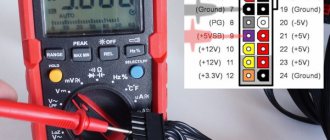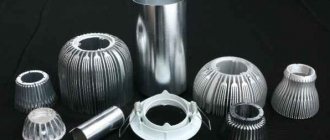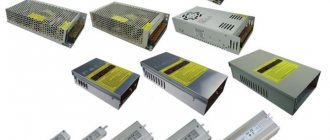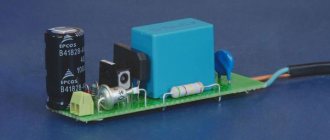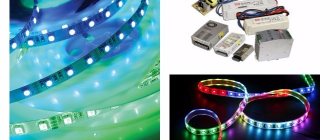When describing the technical characteristics of LED lamps in advertising materials, special emphasis is usually placed on the types of LEDs used in them. However, the reliability of modern lamps is determined not only and not so much by LEDs, but by the power supply. But some important parameters of this unit are not reported by manufacturers even upon request. Therefore, the task of choosing lighting fixtures with high-quality power supplies is very difficult, however, it can be solved.
The reasons why manufacturers focus on LED parameters when promoting lamps to the market have historical roots. Previous light sources had a service life significantly shorter than that of ballasts. As a result, the idea was formed that the light source is the least long-lived part of the device.
LEDs are distinguished primarily by their long service life - on average about 50,000 hours. If the lamp works 10 hours a day, then its service life, due to the parameters of the LEDs, will be more than 13.5 years. This period of time is already comparable to the service life of other components of the lamp or even exceeds it.
Features of terminology
The problem of choice begins with very confusing terminology.
A power supply unit (PSU) is usually called a power source for electronic equipment that converts electrical energy from the network to match its parameters with the input parameters of individual equipment components.
The vast majority of LEDs are powered by DC and have a supply voltage of less than 4 V. If you connect the LEDs in series, then such a chain will have a higher supply voltage. For a number of reasons, connecting LEDs in chains longer than 15 pieces is very rarely practiced. That is, the supply voltage of an array of LEDs in a lighting device usually does not exceed 60 V. At the same time, power supply networks, depending on the country, provide a voltage of 100 - 240 V AC. To match the power parameters of the LEDs and the parameters of the power supply network, a power supply is required.
It should be noted that the term “power supply” is an established concept widely used in engineering practice. However, it is not officially fixed by GOST R 52907-2008, which only contains a definition of the power source. In the previous version of GOST, the concept of “secondary power source” was also officially established, which is absent in GOST R 52907-2008. Using the term “power supply” allows you to distance yourself from autonomous power sources, i.e. galvanic cells and batteries.
\In addition, the term “driver” is often used slang to refer to a power supply unit. In fact, the driver is a device that stabilizes the current that powers the LEDs. Also, some drivers are capable of adjusting the luminous flux of LEDs, i.e. dim them. But the driver does not perform the functions of converting the supply voltage and rectifying the current. Therefore, the node responsible for powering LEDs in 12 or 24 V lamps is a driver. But when powered from a 220 V network, we are talking about a power supply. However, on some power supplies you can find the word driver, which in this context means stabilization of the output current.
Dimmable Helvar power supply with output current stabilization
In lighting engineering, devices that coordinate the power parameters of light sources and the electrical network were historically called ballasts or ballasts. Lighting specialists, when switching to LEDs, did not abandon the terms they were accustomed to and began to use them in relation to power supplies for LEDs.
Another term that is not always correctly used to describe power supplies in LED luminaires is “electronic transformer”. This device, in fact, only converts the voltage to a lower one and increases the frequency of the alternating current from 50 (or 60, depending on the electrical network standard adopted in the country) to several units or tens of kilohertz. Powering LEDs directly from an electronic transformer is used only in garlands and other similar decorative lighting products.
The terminology for LED lamps in terms of power supply devices has not yet been fixed by GOST; in draft standards the term “electronic control device” is used.
To be fair, it should be noted that confusion with terminology is also widespread abroad. The term power supply unit (power supply unit) or simply power supply (power source) is used extremely rarely in lighting engineering. In advertising materials, the designation of the power supply unit as driver is often found, and in general, the designation of the power supply unit in LED lamps as ballast is widespread.
Selecting a Power Option
If the lamps illuminate a room that does not require special quality of light, then it is quite possible to use transformer or pulse type power supplies. In this case, light pulsations due to voltage surges will not be particularly noticeable.
In cases where a high quality light stream is required, and also if this lamp consumes a lot of power, it is recommended to use a driver.
The choice of power supply is also influenced by the location of the lamp. In particular, this affects the degree of protection. In a residential area it should be lower, but in an aggressive environment with dust and moisture the requirements will be higher.
BP classification
Based on their location, power supplies are divided into internal (placed inside the luminaire body) and external (placed outside the body). In this case, external power supplies can be included with the lamp or purchased separately.
Based on their design, power supplies can be divided into two large categories - isolated and non-isolated. A feature of an isolated power supply is that its output does not have a galvanic connection with the input. Thanks to this, a higher level of electrical safety of the device is achieved. The electric potential at the output of a working insulated power supply will under no circumstances reach a dangerous value. In principle, an isolated type power supply is the same classic transformer-based power supply design that has been used for many decades. The primary winding of the transformer is connected to the network through a converter, and the load is connected to the secondary winding through a rectifier. The differences from the classic version are that the transformer does not operate at the mains frequency, but at a higher frequency, and also in the presence of galvanically isolated feedback to stabilize the voltage or current. Isolated power supplies are relatively expensive, but they cope well with voltage surges and impulse noise that exist in Russian electrical networks.
An example of a circuit diagram of an isolated power supply. Source: Macro Group
Non-isolated power supplies have a galvanic connection to the output. Therefore, although the potential difference between the lines at the output of such a power supply is a safe value that does not exceed 60 V DC for LED lamps, nevertheless, the potential between one of the output lines and the ground can be comparable to the mains voltage, i.e. . take on a dangerous value. The advantages of non-isolated power supplies are compactness, low price and slightly higher efficiency than non-isolated power supplies. This is why non-insulated power supplies are so popular among manufacturers of very cheap lamps - in addition to the low cost of the power supply, higher efficiency allows the use of LEDs with lower light output. Non-insulated power supplies are also widely used in LED retrofit lamps, but in some cases they cannot be avoided due to their small size. Due to low electrical safety, non-insulated power supplies can only be internal. The disadvantage of non-isolated power supplies is the penetration of powerful impulse noise into the output, which “walks” through the network. In addition, when a switch is installed in the gap of the neutral wire (which happens when LED lamps are installed to replace pre-existing lighting), the LEDs in the lamp equipped with such a power supply glow faintly when turned off. All this leads to premature failure of LEDs.
An example of a circuit diagram of a non-isolated PFC type power supply. Source: Macro Group
Advanced non-isolated power supplies are often colloquially called PFC from the words Power Factor Correction - power factor correction. They have a higher power factor compared to conventional non-isolated power supplies - about 0.9 versus 0.6. In such power supplies, the problems that cause premature failure of LEDs are partially solved. However, they still lose to isolated power supplies in terms of resistance to voltage surges.
Lamp and driver device
The power supply for a 12V LED lamp is the most common type. Depending on the characteristics of the lamp, it can output 5, 12, 24, 48 V. In this case, the current is converted from alternating to direct. This is a prerequisite for proper operation of the system.
Before considering the structure of this lamp element, you need to pay attention to its place in the design. This will allow you to make repairs if necessary. LED lamps have the same design. If you remove the case, you can see the driver inside. This is a printed circuit board on which radioelements are soldered.
The base of the presented devices most often has a G4 size. The power supply for the LED lamps follows immediately after. Electricity is supplied to the contacts of the cartridge, transmitted to the terminals of the base. Two wires are connected to it, through which voltage is supplied to the driver (power supply). Here the current is transformed to the specified parameters. It goes to the board to which the LEDs are soldered.
A driver is an electronic unit that is a current generator. It, in turn, also has several main components. The voltage from the household network first reaches the filter. It eliminates electromagnetic interference. Next, the current flows to the rectifier. Here it becomes permanent. The next stage of the power supply is designed for power factor correction. The last stage that electric current passes through in this device is a pulse current stabilizer. LEDs are connected to its output.
Any LED lamp has such a device. If you need to assemble power supplies for LED lamps for emergency or main purposes, follow the indicated diagram.
Why "weak link"?
The electronic components of the power supply operate at voltages up to 242 V AC. During power failures, the voltage may briefly increase to 456 VAC. Lightning strikes, switching of powerful electrical equipment and some other factors lead to the occurrence of pulsed noise with an amplitude of up to 4000 V. Therefore, special requirements are placed on the quality of the electronic components of the power supply.
The lifespan of LEDs depends on how long they shine. In contrast, the service life of a power supply is related not only to operating time, but also to storage time. That is, if you did not turn on the lamp, but only stored it in a warehouse, then after some time its power supply will still fail. This is due to the characteristics of electrolytic capacitors used in power supplies - they gradually degrade due to evaporation of the electrolyte. On average, an electrolytic capacitor can be used for no more than 10 years from the date of manufacture. In an incorrectly designed power supply, the electrolytic capacitor overheats, which shortens its service life. In some modern expensive power supplies, the problem is solved by completely replacing electrolytic capacitors with ceramic ones, which are practically “eternal” electronic components.
The simplest scheme
Let the task be to make a primitive LED flashlight with your own hands, powered by one battery. Take, for example, a C503C LED (CREE) with a rated current ILED = 20 mA and a voltage drop ULED = 3.2 V.
We use a 3.7V lithium battery as a power source (if you use AA batteries, you won’t be able to get by with just one).
If you turn on the LED directly, then the current through the LED will be limited only by the internal resistance of the battery, which at best will lead to very rapid discharge, and at worst to failure of the LED. The simplest connection diagram is shown in the figure below.
To limit the current, a resistor is used, the resistance of which is determined by the formula R = (UB-ULED) / ILED. In our case, the resistance will be 25 Ohms.
As the diode power increases, the circuit will become more complicated, because at high currents it is not advisable to use a resistor - the power loss is too large. If the supply voltage has a large range, this circuit is also not suitable, because it does not provide current stabilization.
Reading between the lines
Manufacturers of LED lamps almost always publish information about the LEDs they use, but rarely disclose data about the power supply. However, you can form your own idea of whether the power supply is of high quality or not, based on the parameters of the lamps that the manufacturer openly publishes.
First of all, this is the power factor λ (sometimes it is denoted as cos φ, which is not entirely correct for LED lamps). The larger this parameter, the better. For a high-quality power supply it should be at least 0.85. Simplified power supplies with low reliability usually show themselves by having a low λ value.
PSUs from leading manufacturers are characterized by a high power factor, an example of this is this device from Osram
Lamp manufacturers, of course, know that it is the power supply, and not the LEDs, that limits the service life of the lighting fixture. Therefore, although they indicate “LED service life 50,000 hours,” nevertheless, the warranty period is set based on the numbers for the entire lamp. Usually they base it on how many years the lamp will work if it is turned on around the clock. For example, the warranty period for LED lamps in the mid-price category is usually 3 years. We multiply this period by 8760 hours per year, and we get 26280 hours - this is how long the lamp is guaranteed to work. Please note that this figure is very close to the service life of a typical mid-price PSU - 30,000 hours.
But the most important thing is where the power supply is located and what it looks like. If it is external and connected to the lamp via a connector, then it is definitely isolated (manufacturers usually do not directly violate electrical safety rules). In the event that the power supply is internal, but is made in the form of a separate unified module from one of the leading power supply manufacturers, then most likely it is also isolated. Non-insulated power supplies are usually designed as an integral part of the luminaire design.
Driver for LED
Driver for a variety of LED lamps or street lamps - current converter. Its main function is to receive 220V, and at the output give the necessary 12V.
To save money, you can make a driver from an energy-saving lamp. In fluorescent lamps, most often, the filament simply burns out, but the element itself that provides ignition remains unharmed. From this we can conclude that almost any old lamp will do to make a driver for LEDs.
The lamp is carefully opened along the belt and the wires are bitten off to remove the electronic component of the mechanism. In accordance with the diagram, the future converter is rebuilt and the driver is ready for use.
A dimmable driver is also widely used, because it can be used to adjust the brightness of the LED strip.
PSU manufacturers
Theoretically, the optimal choice is a power supply specifically designed for a specific luminaire model. In practice, this can be successfully implemented either by companies that, in addition to lighting, also have a powerful business in the production of electronic devices (LG, Philips), or lighting companies whose power supplies have proven themselves well in the market (Osram).
In other cases, the preferred option is to use a power supply in the lamp from leading companies specializing in this type of product (Meanwell, Helvar, Vossloh-Schwabe and some others). The use of a unified power supply with an easily replaceable design is also important for possible repairs of the lamp, since the power supply usually fails faster than LEDs.
Developing the topic
Powerful LEDs are powered using current stabilizers - drivers. They can be made either on the basis of discrete components or using specialized microcircuits. The driver can be purchased ready-made, or you can make it yourself - it’s not difficult, considering that there are plenty of diagrams and recommendations on the Internet.
Another important point in organizing power supply for semiconductor light sources: when combining LEDs into groups, it is recommended to connect them in series. This is due to the fact that the voltage drop across the pn junction has a certain spread from device to device, and when connected in parallel, the currents through them will differ.
Power supply of LEDs from 220 V network is organized using so-called network drivers. Essentially, these are switching power supplies for LEDs; they convert mains voltage into stable direct current. Making such a source with your own hands is quite difficult if you are not an expert in this field, and given the wide range of products presented on the modern market, it is also impractical.
External power supplies not included in delivery
There are LED lamps on the market that have a low supply voltage (usually 12 or 24 V). They are designed to be powered from a source with a stabilized output voltage or from an electronic transformer. Often the power supply is not included in the delivery of such lamps, which allows you to save money by installing one power supply for several lamps. If the lamp allows power from both alternating and direct current, then it is better to use direct current, i.e. install a power supply, not an electronic transformer.
When choosing an external power supply, you should keep in mind that maximum efficiency is achieved if the load is approximately 80% of the rated value. Accordingly, by multiplying the power of the lamps connected to the power supply by a factor of 1.25, we will obtain the optimal value of the nominal power of the power supply. Sometimes the power of the power supply is chosen “for growth”, taking into account that additional lamps will be connected to it later. Then the total power of the luminaires of the “first stage” of connection must be 1.2 times greater than the minimum load power of the power supply unit, otherwise the no-load protection will be triggered.
The use of an external power supply, not included in the delivery package, makes it possible to increase the reliability of the system, since only drivers are built into the lamps. The electronic components in them operate at low voltages, so their quality is not so critical. And the user chooses the power supply model independently, based on his needs, and can request all the necessary information from the supplier.
Alexey Vasiliev
Assemble with your own hands
With your own hands you can make not only Ice lamp, but also a simple power supply for it (not switching). The circuit can be transformer or transformerless (the second is simpler). Requires a diode bridge, resistors and capacitors.
The first to be installed is a capacitor that limits the alternating current. Properly selected capacitance guarantees that the required current will be supplied to the LEDs. The voltage of this element is from 300 V.
Important! An electrolytic capacitor is not suitable for a power supply.
A shunt resistor with a resistance sufficient to discharge the capacitor when the lamp is turned off is connected in parallel. Power doesn't matter much.
The next element is a diode bridge, which converts alternating current into direct current. You can buy an assembly or solder several diodes with characteristics suitable for the circuit. The current must be greater than that flowing through the lamp, the reverse voltage is from 300 V.
After the bridge, the electric current is constant, but spasmodic. The situation can be improved by a smoothing capacitor of 300-400 V with a capacity of 10 microfarads. A resistor is connected to it for shunting.
This power supply is suitable for serial connection of up to 75 bright LEDs with a voltage of 3.5 V and a current of 20 mA. The brightness of the glow changes with the capacitance of the first capacitor.
This scheme is not safe enough, since if moisture gets into the lamp, it can cause an electric shock.
If you use a transformer, its power should be one and a half times the power of the lamp. The output should be 12-20 V. After the transformer, a filter capacitance and a stabilizer based on the 7812 microcircuit are turned on, providing an output current of up to 1.5 A.

